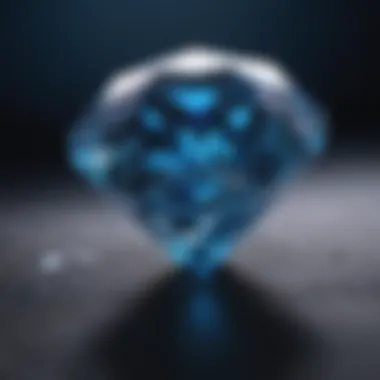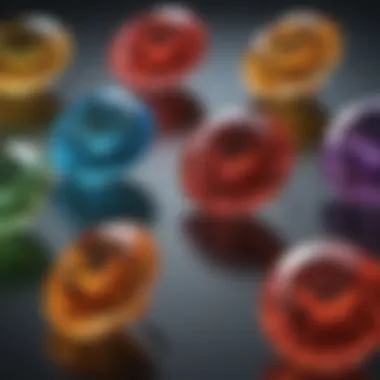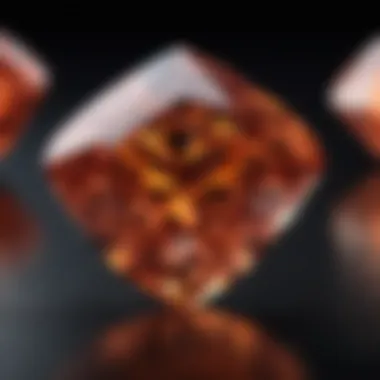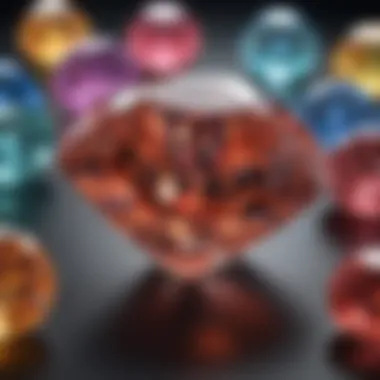Understanding Fluorescence in Diamonds: Colors and Traits


Prolusion
When it comes to the fascination of gemstones, diamonds often take the crown. Their brilliance and rarity make them highly sought after, but there's more to them than meets the eye. One intriguing aspect is fluorescence, a phenomenon that might influence both the visual appeal and the value of these precious stones. As we journey through this article, we'll unravel the layers of fluorescence in diamonds, exploring its common colors, scientific underpinnings, and its impact on the diamond market.
Gemstone Overview
Definition of Gemstones
Gemstones are natural minerals or rocks that have been cut and polished to produce attractive objects used for jewelry, decoration, or in industrial applications. They are prized for their beauty, durability, and rarity, with diamonds sitting prominent at the top of this glittering hierarchy. Their extraordinary hardness and optical properties make diamonds particularly unique among other gemstones.
Classification of Gemstones
Gemstones can be categorized into various classes based on their composition and characteristics. Generally, they fall into two main categories: precious and semi-precious stones. Precious stones, including diamonds, rubies, sapphires, and emeralds, are valued higher due to their rarity and elegance. Semi-precious stones, such as garnets, peridots, and amethysts, although beautiful, tend to be more abundant.
But wait, diamonds can also be classified further. Beyond their color and clarity, their fluorescence adds another layer of complexity. The fluorescence of a diamond refers to its ability to emit light when exposed to UV rays, often resulting in a captivating display of colors.
Fluorescence can significantly impact a diamond's visual characteristics, altering how it appears in different lighting conditions.
Common Fluorescence Colors
Understanding the colors seen in fluorescent diamonds is not merely an academic pursuit; it serves practical purposes for consumers and gem enthusiasts alike. The typical colors observed include:
- Blue: The most common color, often enhancing the diamond's appearance under UV light, which can create a fuller, more vivid sparkle.
- Yellow: Less frequent compared to blue but can appear in some stones, sometimes giving them a warmer hue.
- Green: Rare but can add a unique touch to diamonds, though often seen in lower-quality stones.
- White: Can signify a very subtle glow, mostly undetectable.
These colors form a palette of visual experiences that can influence a buyer's decision.
In closing this section, we see that the study of fluorescence in diamonds offers not just a glimpse into their visual characteristics but also highlights the intricate balance between scientific properties and market factors. This knowledge can enhance appreciation and, ultimately, buying decisions of consumers and collectors alike.
Preface to Diamond Fluorescence
Fluorescence in diamonds is a topic that stirs curiosity among gem enthusiasts and researchers alike. A diamond’s ability to emit visible light when exposed to ultraviolet radiation can significantly affect its appearance, value, and desirability. When sunlight or, more predominantly, UV light shines on diamonds, the interplay between their inherent properties and how they react can unveil striking colors and characteristics. This phenomenon is not merely a curiosity; it carries significant implications for buyers, collectors, and jewelers, making it essential to understand.
Defining Fluorescence
Fluorescence refers to the immediate emission of light by a substance when it is energized by radiation. In the context of diamonds, this means that when a diamond is placed under UV light, it may glow in various colors, which can range from blue to yellow or even green. The specific hue observed depends on the internal structure and composition of the diamond, along with the presence of certain impurities known as color centers. It’s essential to recognize that fluorescence is not a property of all diamonds, which makes it an intriguing aspect of gemology. While some diamonds exhibit pronounced fluorescence, others may not exhibit it at all. This variance can influence the diamond’s beauty and, for some buyers, its value, introducing an element of individuality into each gem.
Historical Context of Diamond Fluorescence Studies
The story of fluorescence in diamonds is one rooted in scientific exploration and market evolution. Early studies on fluorescence began in the early 20th century. Researchers sought to understand how diamonds behave under different lighting conditions, leading to the discovery that many diamonds exhibit this glowing phenomenon. In particular, the 1940s marked a pivotal time when the impact of fluorescence on diamond valuation became more pronounced. During World War II, the demand for diamonds surged, leading to more comprehensive studies focusing on their characteristics, including fluorescence.
A shift in consumer attitudes occurred later in the century, with gemologists realizing that fluorescence could enhance a diamond's appearance by giving it a more vibrant look in certain lighting. It wasn't until the introduction of standardized grading systems that the implications of fluorescence were quantified and more openly discussed among the buying public. Understanding these historical intricacies helps appreciate how far we've come and underlines the importance of fluorescence in today's gemological world. As the marketplace continues to evolve, both jewelers and consumers now consider fluorescence not just a quirk of a diamond, but as an influential factor in its aesthetic appeal and overall value.


The Science Behind Fluorescence
Fluorescence in diamonds is more than just a standout feature; it's a phenomenon wrapped in layers of scientific principles and characteristics that shape both the aesthetic and economic appeal of these gemstones. The colors that emerge under ultraviolet light not only enhance the visual allure of diamonds but also hold clues to their molecular makeup, which serves as a foundation for understanding their broader implications in the market.
When we dig into the nitty-gritty of how fluorescence occurs in diamonds, it’s essential to comprehend the complex interplay of light and matter. This interaction is not merely a side note—rather, it is fundamental in decoding the behaviors and traits of these dazzling stones. Fluorescence isn't just an observed characteristic, but a visual cue that can influence one’s perception of diamond quality and value.
How Fluorescence Occurs in Diamonds
At its core, fluorescence arises when a diamond's atoms absorb energy, typically from ultraviolet (UV) light, which sends them into an excited state. When these excited atoms return to their normal state, they release energy in the form of visible light, thus producing the vibrant colors we see. The initial excitation and subsequent emission of light rely heavily on the diamond's structure and impurities within it. This process illustrates not just the physical nature of the gemstone but also the chemical properties that differentiate one diamond from another.
Several factors dictate how prominently fluorescence is displayed in diamonds, leading us to investigate what ensures its quality. Understanding these elements is crucial for collectors and enthusiasts aiming to decode the significance behind the luminescent allure of diamonds.
Factors Influencing Fluorescence Quality
Impurities and Color Centers
Impurities play a pivotal role in the fluorescence of diamonds. When foreign atoms, such as nitrogen or boron, are incorporated into the crystalline structure during the diamond's formation, they create color centers. These centers can either enhance or diminish the fluorescence quality depending on their type and concentration.
- Key Characteristic: Nitrogen, for instance, is responsible for the commonly observed blue fluorescence. It absorbs UV light and re-emits it in a visible spectrum, enriching the diamond's allure.
- Unique Feature: Notably, diamonds with higher nitrogen impurities tend to exhibit more intense fluorescence. However, this could lead to a paradox where excess fluorescence might obscure the clarity of the diamond, subsequently affecting its valuation.
This intricate relationship between impurities and fluorescence makes them a fascinating subject for understanding both the scientific and financial aspects of diamonds.
Crystal Structure Variability
The unique arrangement of carbon atoms within the crystal structure of diamonds also contributes significantly to fluorescence. Variability in their arrangement can create variations in how they interact with light.
- Key Characteristic: Diamonds that possess a more symmetrical internal structure typically display more consistent fluorescence. This consistency can enhance the overall appeal of the diamond in a competitive market.
- Unique Feature: Each diamond has its own signature, stemming from how the crystal grows and how it adapts to environmental conditions. This signature shapes the fluorescence intensity and color, presenting a blend of advantages and disadvantages. While a well-structured crystal may reflect light beautifully, a less uniform one might either dazzle with unexpected nuances or struggle for visual prominence.
In essence, the science behind fluorescence in diamonds encompasses a mix of chemical, physical, and structural dynamics. Each element influences how we perceive and value diamonds. Through this exploration, enthusiasts gain deeper insights into both the beauty and the complexities entangled within these gemstones.
Common Colors of Fluorescence in Diamonds
Understanding the range of colors that diamonds can exhibit when exposed to ultraviolet (UV) light provides rich insight into their aesthetic and market appeal. Different colors of fluorescence can also serve as a valuable factor for both consumers and collectors alike, shifting perceptions about a diamond's quality and beauty. An often overlooked aspect, fluorescence can stand as a deciding factor in the purchasing process, driving home its importance in the diamond world.
The Most Prevalent Colors
Blue Fluorescence - Characteristics and Significance
Blue fluorescence is the most common color exhibited by diamonds under UV light. Generally considered a desirable trait, it tends to enhance the diamond's appearance, making it look whiter and more brilliant. This specific hue results from certain trace elements, like boron, within the diamond's crystal structure.
A key characteristic of blue fluorescence is that it is subtly soothing. Many people find blue to be pleasing to the eye—an interpretation of elegance and calmness. As a result, a diamond that glows blue under UV light is often seen as a more attractive option among buyers, leading to higher valuations in certain markets.


"The majority of diamonds exhibit some level of blue fluorescence, and it can positively influence perceived whiteness and overall sparkle."
Nonetheless, blue fluorescence does have its drawbacks. In rare cases, strong fluorescence can make a diamond appear hazy or milky in direct sunlight, which might be considered a disadvantage by some connoisseurs. Thus, it’s essential for collectors to understand the balance of blue fluorescence in their specific choice of diamond.
Other Common Colors: Yellow, Green, and More
While blue fluorescence dominates, other colors such as yellow, green, and even white can appear in diamonds exposed to UV light. Yellow fluorescence minimizes the stone's overall visual appeal. In terms of its contribution, yellow fluorescence tends not to enhance the perceived quality of the stone, and many buyers try to steer clear of it.
On the other hand, green fluorescence can diversify a collection. It is rare and can lend a unique character to the diamond, which often appeals to those in the collector community. Unique features of these colors result in a mixed reception in the market. Some appreciate the unusual aspect, while others consider them a potential drawback, as they often don’t complement the traditional image of diamond beauty.
In the broader context, here are some facets of yellow and green fluorescence:
- Yellow Fluorescence:
- Green Fluorescence:
- Makes diamonds appear notably warmer.
- Less sought after compared to blue; often discounted.
- Rare, making it intriguing to niche audiences.
- Can create a unique allure but might not appeal to all buyers.
Comparative Analysis of Fluorescence Colors
When we compare these fluorescence colors, blue remains the golden standard for desirability. It enhances the diamond’s allure and can mask some imperfections. The market trends indicate that buyers are more inclined toward diamonds with blue fluorescence than those showing yellow or other colors, which are often seen as less appealing. This distinction can elevate or diminish a diamond's market value, making knowledge of these colors imperative for savvy investors and collectors.
By examining what different fluorescence colors signify, both from an aesthetic and financial perspective, enthusiasts and professionals can make more informed decisions while navigating the world of diamonds. An awareness of these factors results in a more comprehensive understanding of a diamond's presence in the marketplace.
Measuring Fluorescence in Diamonds
Measuring the fluorescence in diamonds is a vital aspect of understanding their beauty and value. Fluorescence can heavily influence a diamond’s appearance and market demand. Diamonds exhibiting fluorescence tend to catch the eye due to their vibrant glow under UV light. However, it's not just about looks; those working with diamonds need to consider how fluorescence affects valuation, consumer preferences, and the overall market dynamics. This section will delve into the instruments and techniques used for evaluating fluorescence, and why they are essential in the realm of diamonds.
Instruments and Techniques for Fluorescence Evaluation
UV Light Application
Using UV light for evaluating fluorescence is a fundamental technique in gemology. When diamonds are exposed to ultraviolet light, many will exhibit a certain level of fluorescence according to their unique properties. This method excels in clarity and convenience, making it a preferred choice among gemologists. UV light distinguishes different fluorescence colors and intensities, providing an initial assessment of how a diamond may appear in various lighting environments.
One of the key features of UV light application is its ability to reveal discrepancies invisible under standard white light. This is immensely valuable in identifying any clarity issues or inconsistencies that might affect a diamond's beauty or value. Nevertheless, this method does have some limitations. For instance, very high-intensity fluorescence can sometimes mask the diamond's true color balance, presenting an overly vivid hue that might mislead consumers. Accordingly, a thorough understanding of how to interpret these results is crucial.
Professional Gemological Assessment
A professional gemological assessment plays an integral role in accurately measuring diamond fluorescence. With specialized equipment and trained expertise, gemologists can offer a detailed review of a diamond's fluorescing properties. This type of assessment is regarded for its reliability and thoroughness, providing essential insights into the diamond-quality spectrum.
These evaluations typically assess not just the presence of fluorescence but also its intensity and impact on the diamond's overall appearance. A unique feature here is the gemologist’s ability to make nuanced judgments regarding how fluorescence interacts with other attributes, such as color and clarity. However, engaging a professional assessment can be costly and may involve longer wait times. Yet, the investment often pays off by providing reputable insights which can aid buyers in making well-informed purchasing decisions.


Fluorescence Intensity Ratings
Once fluorescence has been measured using the aforementioned techniques, it is often categorized into intensity ratings. These ratings can influence how diamonds are perceived in the market. Managing and understanding these ratings can help both sellers and buyers navigate pricing and desirability in the diamond market, making this aspect pivotal.
In summary, the measurement of fluorescence in diamonds encompasses various techniques, with UV light applications and professional assessments at the forefront. An intricate mix of science and art, thoroughly measuring fluorescence can lead to deeper insight for gemstone enthusiasts, collectors, and professionals alike.
Market Implications of Fluorescence
The impact of fluorescence in diamonds goes beyond their aesthetics; it fundamentally influences their market valuation and consumer behavior. Understanding these implications is crucial for both buyers and sellers within the diamond industry. As fluorescence can either enhance or detract from a diamond's appeal, its role plays a significant part in pricing, purchasing decisions, and overall consumer trends.
Fluorescence and Diamond Valuation
When it comes to valuing diamonds, the presence and nature of fluorescence can change the landscape significantly. In general, diamonds that exhibit strong blue fluorescence tend to fetch a higher price, particularly in markets like the United States. This is largely because strong fluorescence can enhance the diamond's appearance by masking yellowish tones, creating a visually appealing contrast.
- Positive Impact: For many buyers, a diamond that fluoresces blue under UV light appears whiter and more vibrant. This quality appeals particularly to collectors and those looking for engagement rings, where visual impact is paramount.
- Negative Impact: Conversely, for certain markets and preferences, pronounced fluorescence can be a liability. Some buyers perceive diamonds with moderate to strong fluorescence as less desirable, especially if it leads to a milkier appearance under standard lighting conditions. This perception can lead to a reduced valuation in markets that prioritize clarity and purity over the alluring glow of fluorescence.
The general market trend suggests that awareness and education about fluorescence can play a pivotal role. As consumers become more informed about how fluorescence works, its potential benefits in enhancing a diamond's appearance may lead to an increase in demand for fluorescing stones, thus shaping their market value.
Consumer Preferences and Trends
Consumer attitudes towards fluorescence in diamonds are influenced by current trends and cultural factors. As preferences evolve, so does the significance of fluorescence in the purchasing decision process.
- Increasing Knowledge: More gemstone enthusiasts are taking the time to understand the nuances of fluorescence, transitioning from traditional perceptions of desirability. Online forums and social media platforms, such as Reddit and Facebook, are hotspots for discussions, allowing consumers to share experiences and contrasts between fluorescing and non-fluorescing diamonds.
- Cultural Influence: Depending on the region, consumer preferences can vary widely. In markets where diamonds are heavily featured in jewelry design, preferences often lean towards stones that sparkle under mixed lighting. In contrast, some buyers in regions with a strong cultural inclination towards colorless gemstones may shy away from diamonds with noticeable fluorescence.
- Trends Towards Vintage Designs: There's an uptick in demand for vintage and unique diamonds, many of which may exhibit fluorescence. This trend leads to a reassessment of fluorescence’s role in desirability, suggesting that unique characteristics, including fluorescence, may be celebrated rather than minimized.
In summary, fluorescence has a multifaceted influence on market dynamics. Its evaluation not only affects the monetary value of diamonds but also reflects changing consumer preferences that echo broader societal trends around luxury and personal expression. Understanding these implications is essential for navigating the intricate dance of the diamond market.
Ending and Future Perspectives
In wrapping up this exploration of fluorescence in diamonds, we acknowledge its nuanced role not only as a unique physical characteristic of these gemstones but also as an integral part of their market value and aesthetic appeal. Understanding fluorescence just isn’t a mere academic exercise; it offers practical benefits for buyers, collectors, and designers alike. It serves as a bridge between scientific inquiry and market dynamics, highlighting how something rooted in physics can ripple through consumer perceptions and preferences.
Recapping Diamond Fluorescence Insights
To reiterate key points, fluorescence in diamonds primarily manifests as a blue glow under ultraviolet light, a detail that has become synonymous with quality and desirability. This optical phenomenon stems largely from trace elements and their interactions within the diamond's crystal structure. We have discussed various colors, with blue being the most dominant and widely appreciated. However, we also explored rarer hues such as yellow and green, each with its unique implications for valuation.
Key Insights Include:
- The predominance of blue fluorescence in diamonds and its relative desirability.
- The connection between color intensity and market perception, where moderate fluorescence can sometimes enhance a diamond’s overall value.
- The scientific foundation behind fluorescence, including the role of impurities and crystal structure variability.
It’s crucial for stakeholders in the diamond market to understand these insights. Not only does this knowledge enrich one's appreciation of these gemstones, but it also equips collectors and buyers to make better-informed decisions.
Potential Future Research Directions
Looking to the future, research into diamond fluorescence should be multifaceted. Potential areas of exploration could include:
- Impact of Light Environment: Investigating how different types of lighting—natural versus artificial—affect perceived fluorescence colors and intensity.
- Consumer Psychology: Understanding how consumers respond to fluorescent diamonds, especially in terms of marketing and purchasing behaviors.
- Technological Advances in Detection: As gemological technology evolves, new methodologies could emerge that provide deeper insights into fluorescence characteristics, perhaps even enabling more precise grading systems.
- Environmental Implications: Analyzing how natural fluorescence might indicate geological conditions or environmental factors during diamond formation, thus enriching the narrative we associate with each gemstone.
“The future of diamond fluorescence research provides intriguing opportunities that could redefine not only our understanding but also our appreciation of this age-old gemstone.”
In sum, as diamond caretakers unravel more about fluorescence, it isn't just about scientific inquiry; it's about enriching the narrative surrounding diamonds, making them even more desirable, unique, and appreciated by the astute audience of gemstone enthusiasts, collectors, and jewelry designers.



